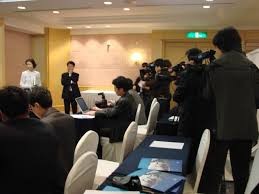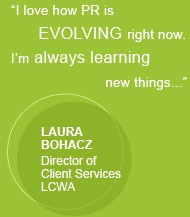What is Corporate Communication?
 Corporate communication plays a key role in how investors, suppliers, employees, competitors, government and the general public perceive a company. The corporate communication department often reports directly to a company’s chief executive officer, while serving as advisers in managing a company’s reputation. They help firm’s leaders prepare for media interviews, develop messages to deliver to investors and employees and suggest new initiatives to keep a company ahead, to make its existence prominent and keeping its communication up-to-date and progressive with its stakeholders. Corporate communication is a management function or department, like finance, operations, logistics or marketing dedicated to the distribution of information to key constituencies, and the implementation of corporate strategy as well as the development of information for a variety of purposes for the organization.
Corporate communication plays a key role in how investors, suppliers, employees, competitors, government and the general public perceive a company. The corporate communication department often reports directly to a company’s chief executive officer, while serving as advisers in managing a company’s reputation. They help firm’s leaders prepare for media interviews, develop messages to deliver to investors and employees and suggest new initiatives to keep a company ahead, to make its existence prominent and keeping its communication up-to-date and progressive with its stakeholders. Corporate communication is a management function or department, like finance, operations, logistics or marketing dedicated to the distribution of information to key constituencies, and the implementation of corporate strategy as well as the development of information for a variety of purposes for the organization.
It consists of both Internal and external communication. Internal communication is the process of exchanging information among the people of different level or internal participants within the organization. It is directly linked to the process of human resources. It connects the employees with the company’s larger picture; reminding them on regular intervals regarding the company’s goals & objectives; letting the employees know about the company’s achievements, advising on corporate strategy, talent management, employee engagement, business strategies, change management, business development, CSR, motivating & empowering employees through various developmental schemes. Further letting the employees learn about the new initiatives taken by the company, training and development of the employees, mentoring and business reviewing etc.
And, external communication is the process of keeping the external participants informed about organization’s well being and how the organization wants the external participants to get involved with their business.
Both internal and external communication mediates heavily on business and its positive influence for furthering the organization. It also holds an important spot in the organization structure. If effectively used, corporate communication can certainly help the organization in overcoming some choppy issues and curtailing the bad media effect. The leaders need to understand and appreciate this and should make use of this level-playing strategic tool for utmost benefit. It helps reducing and ignoring mundane and typecasted messages by reducing the uncomfortable gaps with its stakeholders. It’s no longer a mere ornamental corporate mouthpiece.
Corporate communication consists of some complex responsibilities, such as:
 Rapport with media: Corporate communication managers are friendly with the media at large. It involves write-ups on various happening in the organization such as appointment of new CEO, new products being introduced by the organization, CSR initiatives taken, diversification opted if any, association of the firms with various bodies etc, etc. This department responds to the media’s queries. Corporate communication department watches over planning for news conferences, including selecting the site for an event, arranging for banners and other graphics to be displayed at the event, preparing folders of information to distribute to the media and preparing executives to speak at news conferences. It assists the spokes person with relevant data and organizes the spokes person’s interviews in various media vehicles such as radio, TV, newspapers, websites etc. In short, this department is well associated with the media by devising strategies to do away with any sort of wrong propaganda.
Rapport with media: Corporate communication managers are friendly with the media at large. It involves write-ups on various happening in the organization such as appointment of new CEO, new products being introduced by the organization, CSR initiatives taken, diversification opted if any, association of the firms with various bodies etc, etc. This department responds to the media’s queries. Corporate communication department watches over planning for news conferences, including selecting the site for an event, arranging for banners and other graphics to be displayed at the event, preparing folders of information to distribute to the media and preparing executives to speak at news conferences. It assists the spokes person with relevant data and organizes the spokes person’s interviews in various media vehicles such as radio, TV, newspapers, websites etc. In short, this department is well associated with the media by devising strategies to do away with any sort of wrong propaganda.
 Public Relation: The department is responsible to maintain healthy and sociable relationships with customers by responding to inquiries from them. This task involves producing newsletters, brochures and other printed materials designed for the general public. It also manages the company’s website and social media presence, which includes monitoring what customers and clients are saying about the company on social networking websites and responding to imprecise posts if any. The department is extremely alert to wade off any defaming posts on social media. They respond directly to calls and emails from citizens and customers with questions about a company’s plans or activities. They arrange for speakers from the company to make presentations to local community groups and may facilitate group tours to the company’s works.
Public Relation: The department is responsible to maintain healthy and sociable relationships with customers by responding to inquiries from them. This task involves producing newsletters, brochures and other printed materials designed for the general public. It also manages the company’s website and social media presence, which includes monitoring what customers and clients are saying about the company on social networking websites and responding to imprecise posts if any. The department is extremely alert to wade off any defaming posts on social media. They respond directly to calls and emails from citizens and customers with questions about a company’s plans or activities. They arrange for speakers from the company to make presentations to local community groups and may facilitate group tours to the company’s works.
We can no longer take social media lightly. It isn’t just an online space for posting holiday snaps, pseudo-philosophical opinions or pictures of pets, friends and family functions. Since the use of online social networks like LinkedIn, Facebook, Twitter and YouTube have become widespread, businesses have to incorporate these communication channels into their marketing mix else, they might get left behind. It has become an important tool to increase brand awareness, to promote products or services, to educate, entertain, recruit and collect data about current and prospective clients.
These days corporate blogging has evolved its presence much more than ever imagined. It isfar beyond the idea of personal journaling. Corporate are using blogging as a flexible tool to connect with stakeholders at large. The websites of organizations are supported by multiple blogs subtly discussing the organization’s mottos, goals, and philosophies. Blogs display the products and services of the organization in more than pink health. You may be surprised at the diversity of blogs in these examples; Caterpillar, Starbucks, Marriot, General Electric, Sony, Lever, P&G all of these and many more companies are making best use of blogs.
 Look at the blog of Fiskars and you will be amazed to see how in the world you create passion for scissors!! Fiskars has done it in one of the most creative blogs in the corporate world. The company took help from four scrapbook fanatics who demonstrate their love of crafting with scissors. It’s beyond imagination, that some such idea would work wonders. I tell you friends, marketing is all about imagination. This blog is one of the greatest marketing wonders I have ever seen.
Look at the blog of Fiskars and you will be amazed to see how in the world you create passion for scissors!! Fiskars has done it in one of the most creative blogs in the corporate world. The company took help from four scrapbook fanatics who demonstrate their love of crafting with scissors. It’s beyond imagination, that some such idea would work wonders. I tell you friends, marketing is all about imagination. This blog is one of the greatest marketing wonders I have ever seen.
Similarly, Southwest Airlines has used blogging very well. It is one of the world’s best-known corporate blogs. It’s also one of the most honest blogs. It carries good, bad, ugly experiences of people with airlines. The blog talks about travel and the people who make it happen. This is the anti-corporate-press-release blog. Southwest has wisely used its blog to connect with its employees regarding what passengers want from the airline, what their expectations are.
I have to mention here how Mastercard and Paypal have leveraged social media in innovative, creative way that has shored up their businesses. So coming back to corporate communication departments – they are responsible for using social media in their favor.
 Communication in adversity: In anyevent which threaten public safety or a company’s reputation, corporate communicators need to swoon in as guards. They need to immediately advise CEOs and senior leaders how to manage the crisis. Candidates specially trained in the issues unique to crisis communication helps corporate communicators prepare for events such as chemical spills, blasts, violence in the workplace, an accidental death on the job, murder, layoff announcements and allegations against company’s wrongdoing. They closely guard the company’s reputation by keeping a friendly rapport with the employees to understand their pulse and develop crisis communication plans before disaster such as strikes or layoffs. The corporate communication department needs to work with attorneys, government, regulators, politicians, police, and magistrates. In case any accidents take place they need to respond immediately by rushing the injured employee to the hospitals, getting the aid of insurance etc.
Communication in adversity: In anyevent which threaten public safety or a company’s reputation, corporate communicators need to swoon in as guards. They need to immediately advise CEOs and senior leaders how to manage the crisis. Candidates specially trained in the issues unique to crisis communication helps corporate communicators prepare for events such as chemical spills, blasts, violence in the workplace, an accidental death on the job, murder, layoff announcements and allegations against company’s wrongdoing. They closely guard the company’s reputation by keeping a friendly rapport with the employees to understand their pulse and develop crisis communication plans before disaster such as strikes or layoffs. The corporate communication department needs to work with attorneys, government, regulators, politicians, police, and magistrates. In case any accidents take place they need to respond immediately by rushing the injured employee to the hospitals, getting the aid of insurance etc.
Thus the department works friendly with the in-house people, external stakeholders, government, police, hospitals, insurance companies, entertainment agencies and media, NGOs so on and so forth. With the increase in importance of communication in business, the status of Public Relations (PR) has changed fundamentally. PR has transformed itself and has rechristened as Corporate Communication. It has become one of the pivotal functions in the management. It is required for a cohesive and joint purpose and direction. In the big, bad world putting the right foot forward is a must for any organization. Communication today binds the company with the outside as well as inside stakeholders. The world economy has opened its doors to the global market. This demands an organization strong in foundation, leadership, clear business focus with strategies, motivated skill-sets and adaptable management.
If you are good in written, oral communication; if you like connecting with people, if you are a go-getter and are alert, quick thinker please take corporate communication/PR as your career. It has very bright future.














































